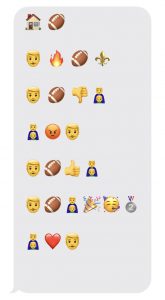WEEK 6
THE BREAKOUT OF THE VISUAL
An Emoji Story

For this activity, I relied mostly on ideas and larger concepts of the film. I had just seen this film the other day so the plot was quite fresh in my mind which made the task easier and more difficult at the same time. All the details were still very prominent so I struggled with what information was the most important that should be included in my Emoji Story. I could have included more detail related to the plot however, this would lend room and require so much more interpretation. Kress (2013) discussed words as being like empty entities that require readers to interpret and make meaning with. I feel this less with words and more with diagrams, images and other forms of visuals.
I used my iPhone for this activity. When texting, the software automatically suggest emojis to use for certain words so I was able to use this to my advantage when re-creating the plot of this movie. Making use of emoji’s more than once in my story really shows who the main character is and what the plot centers around.
I began with the title because that makes the most sense in my mind. Maybe I was following the “fixed order” of things that Kress (2013) discussed. I also couldn’t figure out a way to communicate via emoji if I put the title as my last line instead of my first, that it was in fact the title and not the conclusion to the plot.
As I was completing my readings and this activity this week, I couldn’t help but reflect on the experience of our 21st century learners. My grade 6s for example really struggled this year with interpreting diagrams and images in social studies. We had to work hard on the concept of interpretation and of what message the author was trying to communicate by using this visual. Though this was challenging for them, they much preferred a page of visuals to a page of text. I would get big sighs from them when we would turn the page to find long paragraphs of words. My students have constant exposure to visuals (Instagram, Snapchat, Netflix, Google, etc.) and so one would think their ability to look at them critically would be stronger. Just as the quote from Luke (2003) about Industrial-era schools, we continue to place such importance on their reading abilities (specifically of text and words) and not necessarily with new communication technologies. Students frequently fall short when it comes to “reading” visuals. These visuals that dominate the world around us and will very likely continue to.
References:
Kress (2005), Gains and losses: New forms of texts, knowledge, and learning. Computers and Composition, Vol. 2(1), 5-22.